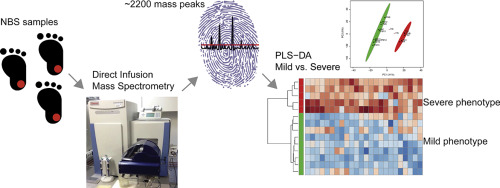当前位置:
X-MOL 学术
›
BBA Mol. Basis Dis.
›
论文详情
Our official English website, www.x-mol.net, welcomes your feedback! (Note: you will need to create a separate account there.)
Prediction of VLCAD deficiency phenotype by a metabolic fingerprint in newborn screening bloodspots.
Biochimica et Biophysica Acta (BBA) - Molecular Basis of Disease ( IF 6.2 ) Pub Date : 2020-02-19 , DOI: 10.1016/j.bbadis.2020.165725 Suzan J G Knottnerus 1 , Mia L Pras-Raves 2 , Maria van der Ham 3 , Sacha Ferdinandusse 4 , Riekelt H Houtkooper 4 , Peter C J I Schielen 5 , Gepke Visser 6 , Frits A Wijburg 7 , Monique G M de Sain-van der Velden 3
Biochimica et Biophysica Acta (BBA) - Molecular Basis of Disease ( IF 6.2 ) Pub Date : 2020-02-19 , DOI: 10.1016/j.bbadis.2020.165725 Suzan J G Knottnerus 1 , Mia L Pras-Raves 2 , Maria van der Ham 3 , Sacha Ferdinandusse 4 , Riekelt H Houtkooper 4 , Peter C J I Schielen 5 , Gepke Visser 6 , Frits A Wijburg 7 , Monique G M de Sain-van der Velden 3
Affiliation

|
PURPOSE
Newborns who test positive for very long-chain acyl-CoA dehydrogenase deficiency (VLCADD) in newborn screening may have a severe phenotype with early onset of life-threatening symptoms but may also have an attenuated phenotype and never become symptomatic. The objective of this study is to investigate whether metabolomic profiles in dried bloodspots (DBS) of newborns allow early phenotypic prediction, permitting tailored treatment and follow-up.
METHODS
A metabolic fingerprint was generated by direct infusion high resolution mass spectrometry in DBS of VLCADD patients (n = 15) and matched controls. Multivariate analysis of the metabolomic profiles was applied to differentiate subgroups.
RESULTS
Concentration of six acylcarnitine species differed significantly between patients and controls. The concentration of C18:2- and C20:0-carnitine, 13,14-dihydroretinol and deoxycytidine monophosphate allowed separation between mild and severe patients. Two patients who could not be prognosticated on early clinical symptoms, were correctly fitted for severity in the score plot based on the untargeted metabolomics.
CONCLUSION
Distinctive metabolomic profiles in DBS of newborns with VLCADD may allow phenotypic prognostication. The full potential of this approach as well as the underlying biochemical mechanisms need further investigation.
中文翻译:

通过新生儿筛查血斑中的代谢指纹图谱预测VLCAD缺乏表型。
目的新生儿筛查中长链酰基辅酶A脱氢酶缺乏症(VLCADD)检测呈阳性的新生儿可能具有严重的表型和威胁生命的症状的早期发作,但也可能具有减弱的表型并且从不表现出症状。这项研究的目的是调查新生儿干血斑(DBS)中的代谢组学谱是否允许早期表型预测,允许量身定制的治疗和随访。方法通过直接输注高分辨率质谱法对VLCADD患者(n = 15)和相匹配的对照组的DBS产生代谢指纹。代谢组学谱的多变量分析用于区分亚组。结果六种酰基肉碱的浓度在患者和对照组之间有显着差异。C18:2-和C20:0-肉碱的浓度,13,14-dihydroretinol和脱氧胞苷一磷酸允许轻度和重度患者分离。两名无法根据早期临床症状进行预后的患者,根据未靶向的代谢组学,在得分图中正确拟合了严重程度。结论VLCADD新生儿DBS的代谢组学特征独特,可能有助于表型的预后。这种方法的全部潜力以及潜在的生化机制需要进一步研究。结论VLCADD新生儿DBS的代谢组学特征独特,可能有助于表型的预后。这种方法的全部潜力以及潜在的生化机制需要进一步研究。结论VLCADD新生儿DBS的代谢组学特征独特,可能有助于表型的预后。这种方法的全部潜力以及潜在的生化机制需要进一步研究。
更新日期:2020-03-19
中文翻译:

通过新生儿筛查血斑中的代谢指纹图谱预测VLCAD缺乏表型。
目的新生儿筛查中长链酰基辅酶A脱氢酶缺乏症(VLCADD)检测呈阳性的新生儿可能具有严重的表型和威胁生命的症状的早期发作,但也可能具有减弱的表型并且从不表现出症状。这项研究的目的是调查新生儿干血斑(DBS)中的代谢组学谱是否允许早期表型预测,允许量身定制的治疗和随访。方法通过直接输注高分辨率质谱法对VLCADD患者(n = 15)和相匹配的对照组的DBS产生代谢指纹。代谢组学谱的多变量分析用于区分亚组。结果六种酰基肉碱的浓度在患者和对照组之间有显着差异。C18:2-和C20:0-肉碱的浓度,13,14-dihydroretinol和脱氧胞苷一磷酸允许轻度和重度患者分离。两名无法根据早期临床症状进行预后的患者,根据未靶向的代谢组学,在得分图中正确拟合了严重程度。结论VLCADD新生儿DBS的代谢组学特征独特,可能有助于表型的预后。这种方法的全部潜力以及潜在的生化机制需要进一步研究。结论VLCADD新生儿DBS的代谢组学特征独特,可能有助于表型的预后。这种方法的全部潜力以及潜在的生化机制需要进一步研究。结论VLCADD新生儿DBS的代谢组学特征独特,可能有助于表型的预后。这种方法的全部潜力以及潜在的生化机制需要进一步研究。



























 京公网安备 11010802027423号
京公网安备 11010802027423号